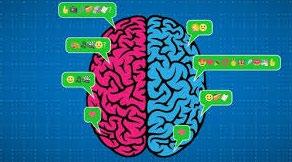Workplace Learning Report







The AI era is here, and leaders across learning and talent development have a new mandate: help people and organizations rise to opportunity with speed and impact.
As AI reshapes how people learn, work, and chart their careers, L&D sits at the center of organizational agility, delivering business innovation and critical skills.
This report combines survey results, LinkedIn behavioral data, and wisdom from L&D pros around the globe to help you rewrite your playbook for the future of work.
Read on for data, advice, and bold ideas.





In a world awake to AI’s impact, skill building is no longer simply a perk for employees — it’s a priority for organizational success. So it’s no surprise that aligning learning to business goals is L&D’s top focus area for the second year in a row.
At the same time, a new priority demands attention. In a single year, helping employees develop their careers climbed from No. 9 on L&D’s priority list to No. 4.
This year’s research will take a deeper look at how career development drives business impact.
1. Aligning learning programs to business goals
2. Upskilling employees
3. Creating a culture of learning
4. Helping employees develop their careers up from No.9 last year
5. Improving employee retention
4 in 5 people want to learn more about how to use AI in their profession.
4x Learners who set career goals engage with learning 4x more than those who don’t set goals.*
90% of organizations are concerned about employee retention and providing learning opportunities is the No. 1 retention strategy.
Moving forward, organizations will succeed by embracing growth as a virtuous cycle. Employee growth, through learning and career development, spurs company growth. Likewise, company growth, through business innovation, energizes people to stay and grow even more.
The three data points on the left tell the story:
• People crave AI skills.
• They’re motivated by career progress.
• Companies must embrace both AI skills and career development to energize and retain talent.
*Source: 2023
“As a talent leader, your impact can define tomorrow’s success. Will you simply adapt, or will you lead your organization into the future?”

Dr. Terri Horton
Work Futurist & Global Advisor at FuturePath, LLC
“The greatest things in history have come from disruption. I am excited to see how AI will challenge us to be more strategic, more creative and more innovative.”
 Naphtali Bryant
Naphtali Bryant
Chief People & Culture Officer at Lucas Museum of Narrative Art
“In the age of AI, senior leaders must create more room at the executive table to align talent strategy and business strategy — it’s not something you simply hand off to HR.”
 Jennifer
Jennifer
Shappley
VP, Talent at“If a company invests in learning today, they will have more engaged and impactful employees ready to tackle tomorrow’s challenges.”
 Sara Dionne VP, Learning & Development (CLO) at Comcast
Sara Dionne VP, Learning & Development (CLO) at Comcast
“AI will be a paradigm shift for the world of work by both democratizing and individualizing learning and reaffirming employee growth as the ultimate goal.”

Guillaume Delacour
Global Head of People Development at ABB
“AI will change the skills needed to do the jobs of the future. It’s up to us to create an environment of curiosity and inspire employees to operate with agility and a growth mindset.”

Ekpedeme “Pamay” Bassey
Chief Learning and Diversity Officer at Kraft Heinz
“AI
will make learning more intelligent, personalized, and flexible.”
 Li
Li
Juan Cheng
Human Resources Director at Chint New Energy
“The future belongs to those who embrace change. We must guide employees to become lifelong learners, especially in AI skills, reducing their discomfort to nurture innovation.”

Sophie Wade
Founder, Workforce Innovation Specialist at Flexcel Network
“As AI shapes learning at work, it’s critical to balance technology’s efficiency with the authenticity of human-centric power skills.”

Jenna Alexander
Talent Centre of Excellence (TCoE) Leader for Global Internal Talent Acquisition at Randstad
The door to the C-suite keeps opening wider. Learning is critical in the age of AI, and L&D is well-positioned to lead important conversations about business impact.
Likewise, company leaders are aware that learning is a worthy investment. According to the LinkedIn Executive Confidence Index, in the next 6 months, 9 out of 10 global executives plan to either increase or keep steady their investment in L&D, including upskilling and reskilling.
Percentage of learning pros who say L&D has a seat at the executive table
+5 percentage points in 2 years L&D’s voice is growing.
When it’s time to meet with executives, L&D pros can cite new LinkedIn research that demonstrates how learning drives desirable business outcomes. This analysis uses LinkedIn platform data to score companies on a learning culture index based on:
• size of L&D team
• rate of employee skill development
• volume of learning-related posts on the LinkedIn platform
It then assesses the companies’ performance on critical talent metrics. The findings are striking. Companies with strong learning cultures see higher rates of retention, more internal mobility, and a healthier management pipeline compared to those with smaller levels of commitment.
Analysis scores companies on a learning culture index, then assesses rate of retention, internal mobility, and promotions to management.
Internal mobility
Promotions to management
Another talking point: learning is a secret sauce for camaraderie and meaning. As organizations continue to grapple with how best to engage dispersed and diverse teams, learning enhances people’s sense of connection and significance in their work.
In short, organizations that invest in learning will reap the reward of having people who are more invested in their organization’s success.
7 in 10 people say learning improves their sense of connection to their organization.
8 in 10 people say learning adds purpose to their work.



Chapter 2
Tomorrow’s success requires skills agility — harnessing the right skills at the right time for the right work.
To unlock skills agility for their organizations, L&D pros must first let go of time-consuming tasks of the past — like laboring over custom content and lengthy training sessions. AI holds great promise for personalization, allowing more individuals to chart their professional destinies.
Likewise, career development and internal mobility programs that align individual aspirations with organizational business priorities represent the path to accelerated progress.
Let’s look at what’s helping organizations build nimble and adaptable skills at scale.
Before we examine what’s accelerating skills agility, let’s look at what’s not adding speed. For the third year in a row, most weighty initiatives (expensive, one-size-fits-all programs that aim to reskill hundreds or thousands of employees at once) are still at the planning and activation stages. Each year, fewer than 5% have advanced far enough to measure success.
The Harvard Business Review sums it up well: “Among [companies] that have embraced the reskilling challenge, only a handful have done so effectively, and even their efforts have been subscale and of limited impact.”
Percentage of organizations working at each stage to implement large-scale programs from 2022 to 2024
In each year, 4% to 5% had not yet started their projects.
Increasingly, the best approach to skill building looks to be dynamic, efficient, and tailored to individual career motivations. It’s no wonder career development popped as a rising priority at the top of this report. And when individual career development aligns with a company’s priorities, people and organizations build the critical, future-facing skills to navigate constant change.

“Each
employee has their own aspirations, experiences, and strengths. AI will enable more and more learners to tailor their learning and shape their careers.”
Shruti Bharadwaj Head, Talent, Learning & Culture at AirtelThis year’s research delves into the state of career development across the globe, finding that about 40% of organizations have mature career development initiatives — meaning they invest in career programs that yield positive business results.
Companies in this category prioritize learning (68% have online learning programs). They also offer programs that put individuals’ career goals front and center (leadership development, shared internal jobs, mentorship, individual career plans, and mobility).

By nature, younger workers start in entry-level jobs and are the hungriest for advancement. Companies that want to attract and engage Gen Z, the rising cohort of workers born after 1996, are wise to tap into the generation’s passion for progress. If there’s any doubt about whether Gen Z wants to learn and grow, the numbers add clarity.
Percentage of Gen Z who agreed that “Through learning, I can explore potential career paths at my company” compared to other generations
Millennials, Gen X, Baby Boomers (born before 1996)
+16 percentage points for Gen Z

“What works well for Gen Z works well for everyone. Employees all want to see how learning translates to something that matters to them.”Christopher Lind VP, Chief Learning Officer at ChenMed
Empowering people to build skills for career progress starts with a simple piece of advice: your future belongs to you.
Re-enter AI. In the years ahead, AI will become more common as a coach, advisor, or problem-solving assistant. While AI-powered coaching is not the only resource companies can tap into, it could be the answer to a problem that’s dogged L&D pros — how to provide personalized career development at scale.
47% of companies are investing in career mentoring and coaching to boost employee retention.

Most learning leaders see the rising potential of internal mobility. Companies that encourage employees to explore and stretch into different internal roles reap higher retention rates, a more agile pool of workforce skills, and employees with deeper cross-functional knowledge.
But many companies are still at the starting line, seeking the right cultural shifts to help employees overcome common barriers, such as bias in favor of external hiring and managers who hoard talent.
One tip: don’t get bogged down trying to build the perfect internal mobility program. Brainstorm small steps your organization can take today.
33% Only 1 in 5 of organizations have internal mobility programs.
employees has strong confidence in their ability to make an internal move.

Because internal mobility is a newer goal for many, the question of where it sits in an organization’s structure can be muddy. Does talent acquisition lead these efforts, or L&D, or another group?
Two things are clear:
Shared leadership is common. For more than a third of organizations, internal mobility is shared between two or more roles and often includes the head of HR.
Respondents could select more than one function.
Ownership frequently sits at the top of human resources. In almost half (48%) of organizations, the head of HR owns or co-owns responsibility for leading mobility.

Let’s revisit two of the focus areas at the top of the report. For organizations looking to align learning with business goals and help employees develop their careers, internal mobility stands out as an effective solution.
L&D can help people and businesses assess where skills are needed. Then they can equip people to move to new roles where their skills can grow and develop in sync with business needs — the very definition of skills agility.
87%
of L&D pros say they can show business value by helping employees gain skills to move into different internal roles.

“L&D pros must help employees prioritize three things: skills for the job they do now; skills for the job they want tomorrow; and skills that will serve them for life.”
Geraldine Murphy
Global Learning Experience Manager at The Heineken Company


Chapter 3
Impactful tactics — and bold ideas — inspire a brighter future.
While learning leaders face daunting demands, it pays to cultivate a purposeful vision. Agile skills are the most valuable gift you can give to people, to your organization, and to yourself.
Read on for actions to prioritize today and ideas to inspire tomorrow.

As shared at the top of the report, aligning learning programs to business strategies is L&D’s No. 1 focus area for the second year in a row. It’s no surprise that L&D pros are cultivating their data literacy.
54% more L&D pros list analytical skills on their LinkedIn profiles compared to a year ago.
Aligning learning to business is still a new muscle for L&D pros. Many are still preoccupied with “vanity metrics,” such as employee satisfaction or the number of trainings delivered (regardless of efficacy).
Success starts with small experiments to gauge progress on critical priorities. For those who do chart business outcomes, productivity and performance are the most common objectives.
Performance reviews
Taking a deeper dive into skill trends, we see L&D pros adding a range of additional human skills (or soft skills) to meet the demands and opportunities of the AI era.
At the risk of stating the obvious, don’t forget to prioritize your own learning.
“Human skills” with the highest growth rates from October 2022 to October 2023 among L&D professionals globally
of L&D pros agree that human skills, or soft skills, are increasingly important.
As skills evolve to meet AI opportunities, learning and growth will be central to jobs.
Increasingly, daily work will include microlearning (or even “nanolearning”) — short bursts of instruction to help people make progress in small bites. Engaging, personalized, and flexible learning in the flow of work helps people solve specific problems and invest in their futures without dropping a ball.
47%
of L&D teams plan to deploy microlearning programs in 2024.

What if CLOs become Chief Skills Officers?
“Many C-suite executives don’t understand the real value of learning: they see it as just a benefit or nice-to-have. When you talk to business leaders, their questions will instead revolve around business strategy, and how learning will help you get there. So even if Chief Learning Officers don’t officially change our titles, we should think of ourselves as Chief Skills Officers, or Chief Upskilling Officers, in charge of strategically building skills that will drive tangible outcomes for the business.”
 Amanda Nolen Co-Founder at NilesNolen
Amanda Nolen Co-Founder at NilesNolen
What if companies incentivize their leaders to export their talent?
“LinkedIn research shows that only 19% of employees are encouraged by their organizations to explore internal role changes. What is often getting in the way is leaders’ fear of losing their top talent without the ability to backfill. Imagine a future where leaders are considered talent builders and they are rewarded for exporting talent to other departments in their organization. Imagine a future where not just managers, but executives sponsor and model internal movement themselves. By unlocking doors for our in-house talent, there’s no limit to the innovation that becomes possible for both our employees and our organizations.”
 Stephanie Conway Senior Director, Talent Development at LinkedIn
Stephanie Conway Senior Director, Talent Development at LinkedIn
What if our talent rotations span across companies?
“Internal mobility is a great idea for individual companies, but what if we think even bigger?
A cross-industry talent exchange program with temporary position swaps among employees with comparable functions and tenure levels would accelerate skill-building for all. This initiative, spanning vendor-customer partnerships and collaborations across various sectors, introduces fresh perspectives, promotes an exchange of best practices, and enriches skill sets. Employees gain a deeper understanding of diverse business environments, contributing to a dynamic, adaptable workforce.”
 Chris Louie Head of Talent Development at Thomson Reuters
Chris Louie Head of Talent Development at Thomson Reuters
What if we blur the lines between education and work?
“We need to demolish artificial silos between pipeline development, talent acquisition, learning, and workforce planning. Let’s build one continuous talentcuration cycle with human-centered, market-aligned pathways connecting middle school, high school, and post-secondary learners to quality jobs. Take United Airlines, who faced a pilot shortage; they created Aviate, a training academy with scholarships and hands-on learning intended to diversify their historically white male pilot pipeline. Corporations can — and should — build the talent they need. We all have the power to create something new if we can question and rebuild traditional structures.”
 Cat Ward
VP, Employer Mobilization at Jobs for
Cat Ward
VP, Employer Mobilization at Jobs for
the Future
What if we treat career navigation as a mission-critical skill set?
“Leveraging relationships, identifying strengths and interests, and tapping into personal curiosity are all things that can help employees grow their careers — and fuel retention within your organization. Finding ways to teach employees the skills and capabilities that can help them navigate their career in a self-sustaining way, outside of formal learning moments, will unlock growth for them and growth for your organization.”
 Al Dea Founder at Edge of Work
Al Dea Founder at Edge of Work
What if we make work about skills rather than roles?
“The org chart has been the way we organize work for over 100 years. What if, instead, we organized the people around the work? Knowing the skills that people have allows organizations to bring in-house talent in as advisors, leaders, or specialists with the skills that are exactly right for a project. With a skills-first mindset, organizations help employees develop skills that are crucial to the organization’s success and interesting and fulfilling to the employees themselves. Internal talent pools become much more adaptable, mobility increases, and there is a natural incentive to develop new skills.”
 Dani Johnson
Co-Founder & Principal Analyst at RedThread Research
Dani Johnson
Co-Founder & Principal Analyst at RedThread Research
What if one-size-fits-all learning disappears?
“We’re transitioning from an era of one-size-fits-all learning to one where personalized learning is the norm. This transition propels the shift from traditional courses to dynamic learning resources. Human-driven professional development will focus on self-discovery and inner leadership facets, such as values and purpose, while highlighting the significance of connection. AI will provide real-time guidance, offering insights for tasks like career discussions, strategy development, or marketing campaigns.”
 Geraldine Murphy
Geraldine Murphy
Global Learning Experience Manager at The Heineken Company
What if we believe emotion is just as important as cognition?
“Emotion is not important to learning. Emotion is learning. Our reactions to our experience determine what we store and form the basis from which we reconstruct a memory. Only what moves us, changes us. To say that ‘emotion is important to learning’ is to say ‘cognition is important to learning’. Let’s help employees with the things they care about or move them to care about new things. These are the two ways we can help them.”
 Nick Shackleton-Jones CEO and Founder at Shackleton Consulting
Nick Shackleton-Jones CEO and Founder at Shackleton Consulting
What if learning becomes a core focus in every role?
“The programs that learning and development pros provide, from onboarding to mentoring to specific upskilling, transcend skill-building; they help employees align their learning with their growth at a company. At Mars, our associates are urged to own their careers and managers are empowered to drive both their own and their employees’ career development, creating the conditions for significant internal mobility. I believe it’s critical for each employee to prioritize learning, no matter what their title is.”
 Alex Halem Head of Learning, Mars Global Services at Mars, Incorporated
Alex Halem Head of Learning, Mars Global Services at Mars, Incorporated
What if everyone has access to AI-driven immersive learning?
“AI-driven immersive learning will bridge the gap between theory and practice, allowing employees to learn concepts and apply them in an immersive, simulated environment. Some companies have started creating “Experience Learning Worlds” (ELWs), like digital hospitals and cities, that allow learners to explore different industries in a simulated environment. AI will give learners challenges to solve and will give them feedback on how they’re doing, helping them learn new skills and even get certifications and experience. This will change the way employees learn because it allows them to practice technical skills before they actually start working.”
 Manpreet Singh Ahuja Partner, Chief Digital Officer at PwC India
Manpreet Singh Ahuja Partner, Chief Digital Officer at PwC India
What if we make the first 30 days all about the employee?
“Let’s transform onboarding into a collaborative opportunity for employees, managers, and L&D pros to shape each job’s ‘mission.’ Even individuals with the same title at the same organization seldom have identical responsibilities. L&D should collaborate with managers to identify employees’ skills, learning preferences, and goals. During onboarding, L&D pros should ask employees and managers: What are the employee’s goals? What skills do you want to build, and how will these skills benefit our business? Then, build learning programs aligned with these desires. Starting with agreed-upon goals enhances the employee’s engagement and motivation — and helps ensure learning closes skill gaps.”
 Dorna Ericksson Shafiei VP, Talent Management at Atlas Copco
Dorna Ericksson Shafiei VP, Talent Management at Atlas Copco
What if everyone has an AI-powered career dashboard?
“In the future, everyone will have an AI-powered learning and development strategist to keep track of their career metrics and offer an at-a-glance dashboard reviewing how they’re doing at work, including engagement levels, mood, feedback, strengths and weaknesses, and contributions to the team’s strategic priorities. AI strategists will advise on skills and experiences employees need to succeed by analyzing data from the most successful people in a company and formulate a customized menu of options for employees to enhance their learning and growth.”
 Crystal Lim-Lange CEO and Co-Founder at Forest Wolf
Crystal Lim-Lange CEO and Co-Founder at Forest Wolf
What if instead of moving faster, we choose to stay still?
“Counterintuitive as it may seem in our fast-paced, tech-driven world, it would benefit us all to embrace a profound truth: that embracing stillness can be more powerful than keeping pace with the relentless march of technology. This stillness isn’t about idleness, but about creating a mental space where true clarity and innovative ideas can emerge. It’s a necessary respite in the constant noise — a silent rebellion against the myth that to be productive, we must always be in motion. This is the unexpected rhythm of progress in the AI era: the power of pause.”
 Christopher Lind VP, Chief Learning Officer at ChenMed
Christopher Lind VP, Chief Learning Officer at ChenMed

Interpersonal Skills

 By Jeff Toister Measuring
By Jeff Toister Measuring
Learning Effectiveness
with Emotional Intelligence
Problem Solving

People Management

and Managers


Conclusion No one can build the future alone.
Learning at work is not merely a task but a dynamic trek that empowers people and organizations to unlock untapped potential. Likewise, building the future is also a journey — one that need not be traveled alone.
Contact sales to learn more

The LinkedIn Learning 2024 Workplace Learning Report surveyed 1,636 L&D and HR professionals with L&D responsibilities who have some influence on budget decisions, and 1,063 learners. Surveyed geographies include: North America (United States, Canada); South America (Brazil); Asia-Pacific (Australia, New Zealand, India, Japan, Cambodia, Indonesia, Singapore, Malaysia, Myanmar, Philippines, Thailand, Hong Kong); and Europe (United Kingdom, Ireland, Belgium, Netherlands, Luxembourg, Norway, Finland, Sweden, Iceland, Denmark, France, Germany, Austria).
The insight that states, “Learners who set career goals engage with learning 4x more than those who don’t set goals” is based on studying a cohort of learners who initiated their LinkedIn Learning account between February 6 and February 10, 2023. We tracked engagement of these learners for the following 3 months and compared the difference in engagement levels for time spent learning between learners who did vs. did not set a career goal.
Behavioral insights for this report were derived from the billions of data points generated by the 900 million members in over 200 countries on LinkedIn today. Specific analyses:
This analysis looks at the Fastest Growing Skills among L&D professionals (globally) between October 6, 2022, and October 6, 2023. “Fastest Growing Skills” are the skills that have seen the largest year-over-year growth among L&D professionals specifically. One way to interpret these findings is to view fastest growing skills as the skills that are already important today — the skills that many members in a given population are developing and adding to their profiles.
To determine whether companies have a stronger or weaker learning culture, we calculated the deciles to which they belong to in each of the following categories and created a simple scoring index that assigned more points to companies demonstrating these components of learning culture, and fewer points to companies not demonstrating as many components of learning culture:
• Skills development: the median number of skills employees added to their profile while they were employed in a position at the company in the last 12 months.
• L&D team size: identified 40+ L&D occupations and the number of employees at each company in these occupations.
• Learning-related company posts: given the large volume of company posts, we used the Bernoulli method to extract random samplings of company posts in the last 12 months and quantified the number of posts that mentioned ‘learning,’ ‘upskilling,’ and ‘skills’ in English.
The outcomes are defined as follows:
• Internal mobility: All data reflects aggregated LinkedIn member activity as of August 2023. We’ve defined internal mobility as any point at which an employee took a new position at the same company in the last 12 months ending August 2023. To calculate internal mobility rates, we included only companies with at least 100 transitions and calculated the median rate.
• Leadership promotions: We considered all internal promotions that occurred in the last 12 months by the company and calculated the percentage of leadership promotions that took place (i.e. member was promoted to a manager role or higher).
• Retention: the median amount of time that all current employees have been employed with their company.
Survey data
Alexander Foss
Stephanie Scalice
Meng Zhao
LinkedIn platform insights
Manas Mohapatra
Cesar Zulaica
Adriana Zurbano
Editorial & production
Anne McSilver
Sonya Bessalel
Carl Brinker
This report was informed by insightful contributions from learning leaders around the world, to whom we owe our sincere thanks, including:
Jenna Alexander at Randstad
Ekpedeme “Pamay” Bassey at Kraft Heinz
Shruti Bharadwaj at Airtel
Naphtali Bryant at Lucas Museum of Narrative Art
Li Juan Cheng at Chint New Energy
Stephanie Conway at LinkedIn
Al Dea at Edge of Work
Guillaume Delacour at ABB
Sara Dionne at Comcast
Dorna Eriksson Shafiei at Atlas Copco
Stephanie Fitzpatrick at UnitedHealth Group
Justin Foster at Radian
Alexandra Halem at Mars
Dr. Terri Horton at FuturePath, LLC
Dani Johnson at RedThread Research
Crystal Lim-Lange at Forest Wolf
Christopher Lind at ChenMed
Chris Louie at Thomson Reuters
Geraldine Murphy at The Heineken Company
Lori Niles-Hofmann at NilesNolen
Amanda Nolen at NilesNolen
Nick Shackleton at Shackleton Consulting
Jennifer Shappley at LinkedIn
Manpreet Singh Ahuja at PwC India
Sophie Wade at Flexcel Network
Cat Ward at Jobs for the Future
